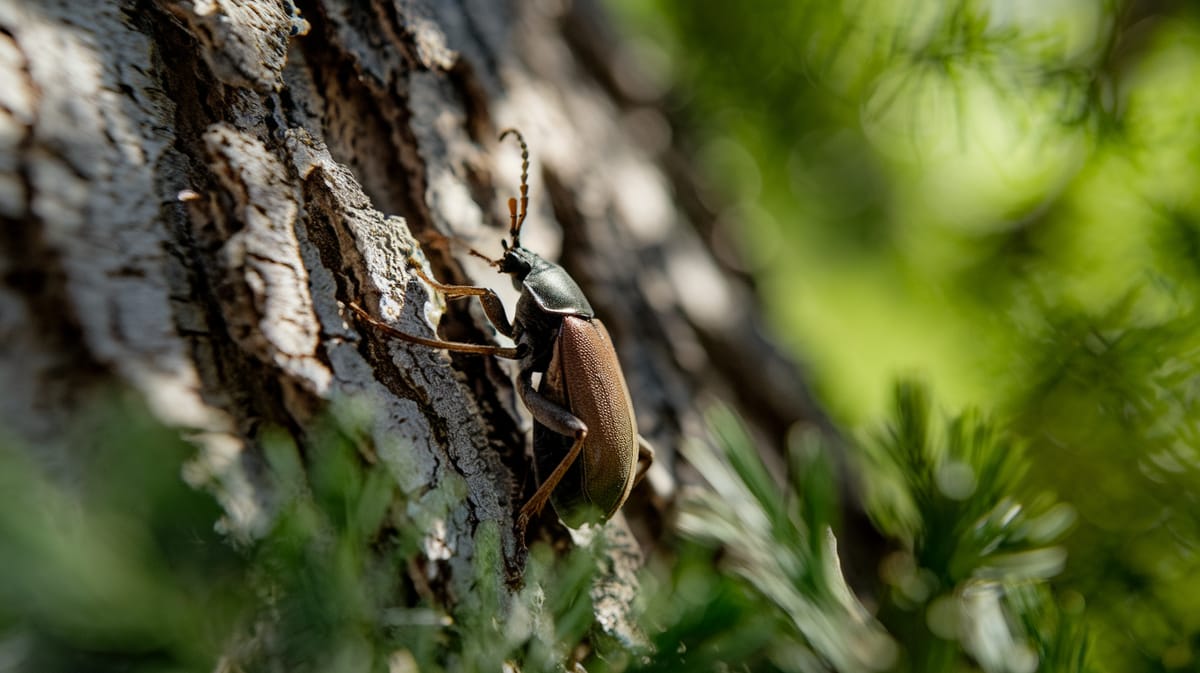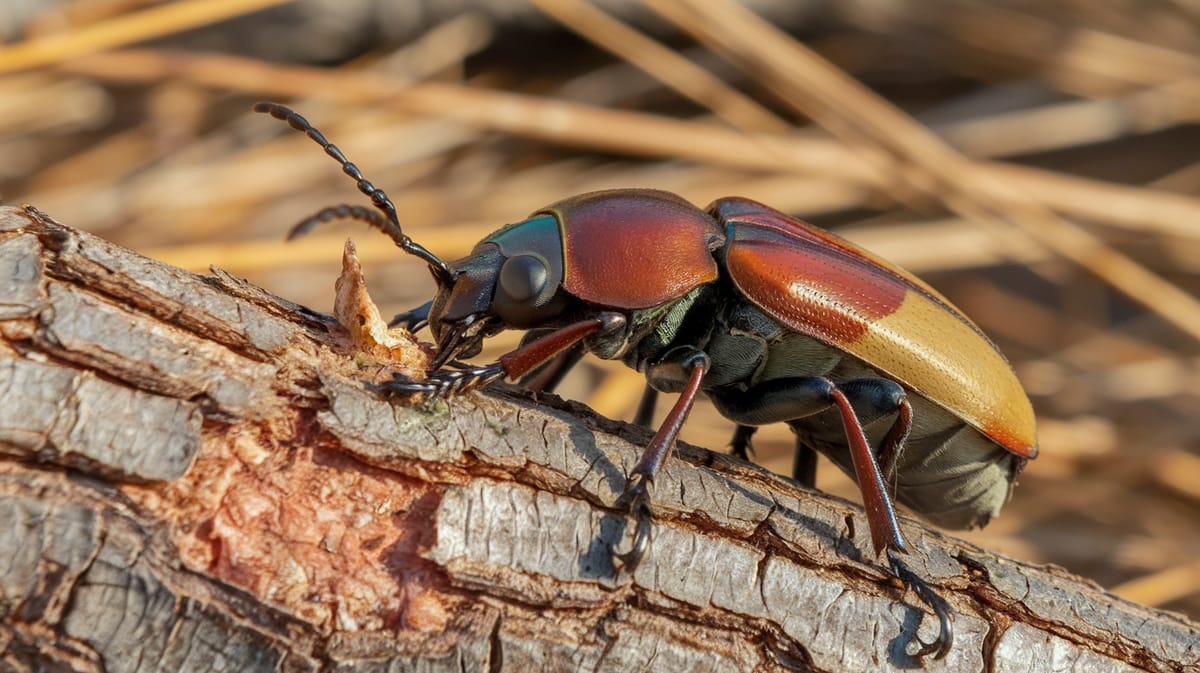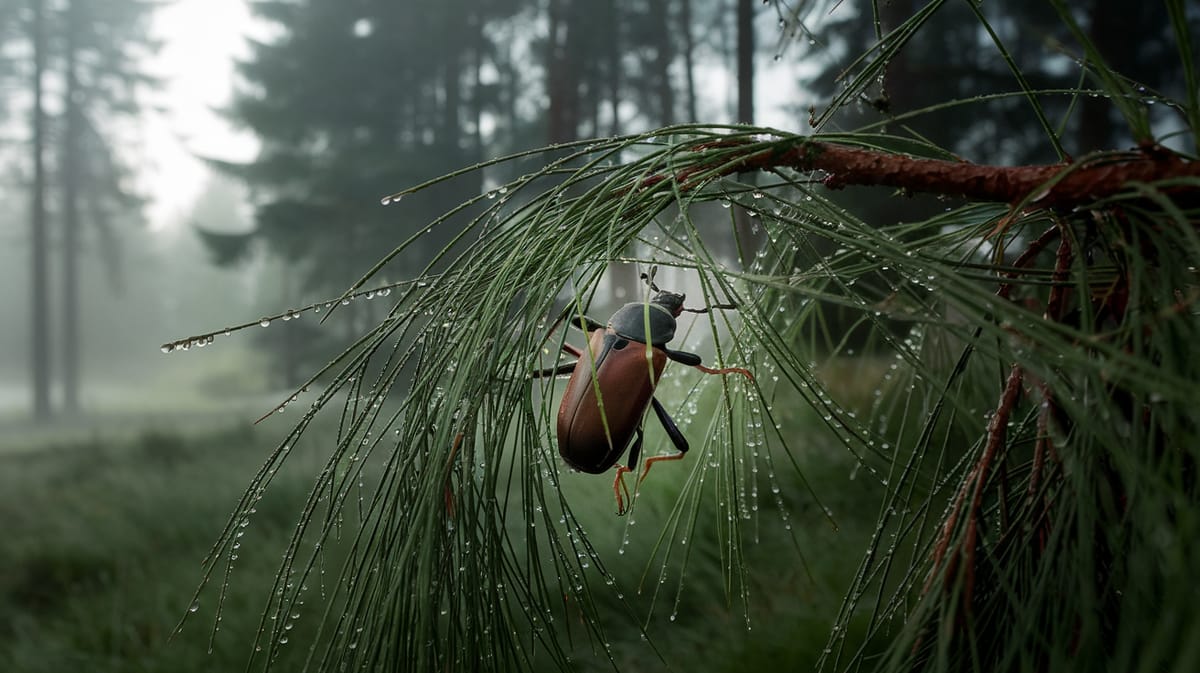Pine Beetle
Ingenious architects of the forest, Pine Beetles expertly burrow into tree trunks, playing a crucial role in forest ecology by recycling dead wood. Their symbiotic relationship with fungi aids in nutrient cycling.

Key Insights at a Glance
Did You Know?
Taxonomy & Classification
Pine beetles are specialized bark beetles with strong mandibles, enabling them to bore into tree bark, playing a crucial role in forest ecology. Let's understand the evolutionary journey and classification of these remarkable herbivores, decomposers.
Species Diversity
There are about 12 species within the genus Dendroctonus, each adapted to specific pine hosts across North America.
Evolutionary Adaptations
Pine beetles evolved over 30 million years ago, developing symbiotic relationships with fungi to efficiently decompose tree tissues.
Lifecycle and Growth
A remarkable journey of transformation from Egg to Adult.
Egg
Laid under bark, these eggs are well-protected and begin the life cycle with development driven by ambient temperature.
Larva
Larvae tunnel through the inner bark, feeding and creating galleries which interrupt the tree’s nutrient flow.
Pupa
Within the bark, larvae transform into pupae, undergoing metamorphosis to prepare for their adult form.
Adult
Adults emerge with developed wings, ready to mate and disperse to colonize new trees, continuing the cycle.
Dietary Habits
A specialized herbivore, this insect targets pine trees, using pheromones and enzymes to exploit its woody diet efficiently.
| DIET TYPE | DESCRIPTION |
|---|---|
| Primary Diet | Primarily feeds on the inner bark and phloem of pine trees, crucial for growth and survival. |
| Secondary Diet | Occasionally consumes the outer bark and cambium layer, especially during larval stages or when food is scarce. |
| Occasional | Rarely ingests fungus and spores, aiding in nutrient absorption during extreme environmental stress. |

Behaviour and Adaptations
Discover the unique traits that enable the Pine Beetle to thrive in forest ecosystems.
Bore Tunneling
Efficiently bores through pine bark to lay eggs, ensuring offspring's survival.
Chemical Communication
Uses pheromones to coordinate mass attacks on trees, overwhelming defenses.
Cold Adaptation
Survives harsh winters by producing antifreeze proteins to prevent cell damage.
Ecosystem Impact
Pine Beetles play a vital role in forest ecosystems by contributing to ecological balance and sustainability.
Nutrient Recycling
Pine Beetles decompose dead trees, enriching soil with nutrients essential for plant growth.
Habitat Creation
Their activity helps create habitats for other species by breaking down trees.
Population Control
By targeting weakened trees, Pine Beetles help maintain healthy forest populations.
Conservation Challenges
Addressing key threats specific to Pine Beetle conservation.
Climate Change
Warming temperatures increase beetle survival and expansion, damaging forests.
Habitat Degradation
Logging and land development reduce suitable habitats for the beetle.
Forest Fires
Intensified fires disrupt ecosystems and beetle lifecycles.
Frequently Asked Questions
How long do Pine Beetle live?
Pine beetles typically live for about one year. Their lifecycle includes stages such as egg, larva, pupa, and adult. The most activity occurs during their adult phase, where they infest and reproduce in trees, primarily attacking weakened or stressed pines.
What do Pine Beetle eat?
Pine beetles primarily feed on the inner bark of pine trees. This feeding disrupts the tree’s ability to transport nutrients and water, often leading to the tree's death. They are especially active in forests with high concentrations of pine species.
Are Pine Beetle poisonous?
Pine beetles are not poisonous to humans or animals. They pose no direct threat to human health but can significantly impact forest ecosystems and commercial forestry by damaging and killing trees.
Are Pine Beetle endangered?
Pine beetles are not considered endangered. In fact, they are quite widespread and can cause extensive damage to pine forests, particularly during outbreaks, which can lead to significant tree mortality.
What do Pine Beetle symbolize?
Pine beetles do not have a widely recognized symbolic meaning. They are often associated with forest health issues, as their infestations can indicate or lead to the decline of pine tree populations.
Do Pine Beetle bite?
Pine beetles do not bite humans. Their mouthparts are adapted for boring into tree bark, not for biting or stinging humans or animals.
What color are Pine Beetle?
Pine beetles are typically dark brown or black. Their coloration helps them blend into the bark of pine trees, providing some level of camouflage from predators.
Does a Pine Beetle have wings?
Yes, adult pine beetles have wings. These wings allow them to fly from tree to tree, seeking new sites for infestation and reproduction.
What does a Pine Beetle look like?
Pine beetles are small, cylindrical insects, usually about 3 to 5 millimeters long. They have a hard exoskeleton, and their coloration is generally dark brown or black, matching the bark of their preferred pine hosts.
Is a Pine Beetle an insect?
Yes, a pine beetle is an insect. As a member of the order Coleoptera, pine beetles are true beetles with distinct life stages, including egg, larva, pupa, and adult.
Related Insects
Discover insects with similar characteristics to Pine Beetle - including shared habitats, diets, and taxonomic classifications
Share this profile
Help others discover Pine Beetle
